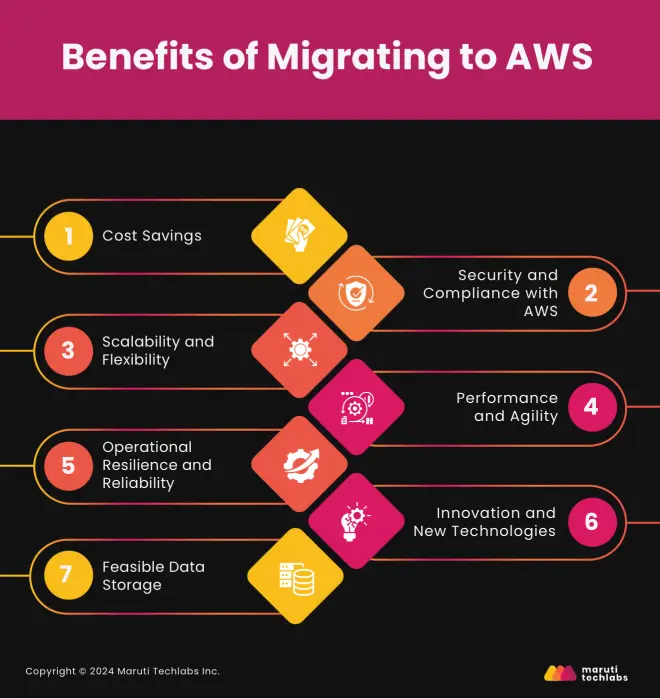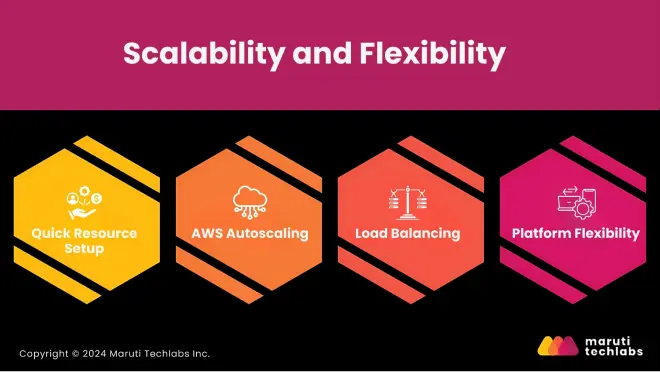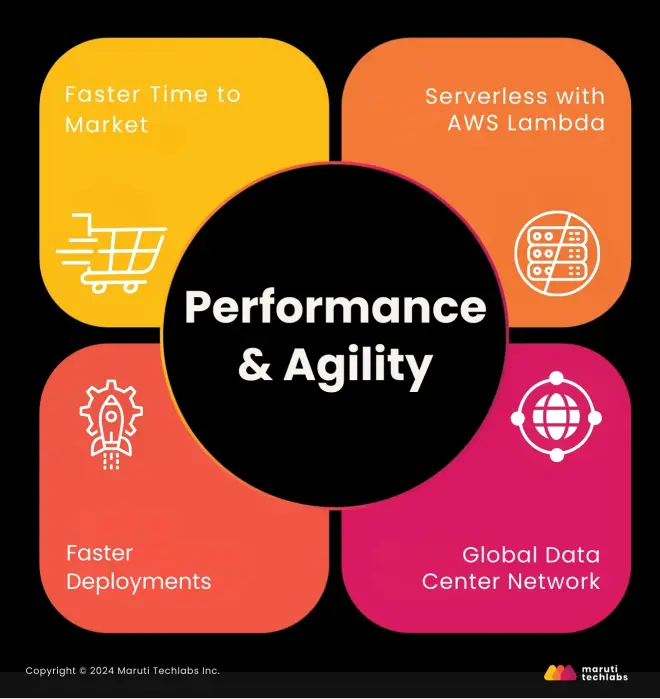

Top Benefits of Migrating IT Resources to AWS Cloud






AWS provides a flexible, secure environment that grows with your business. Switching your IT resources to AWS Cloud allows you to scale up or down effortlessly, ensuring your data and applications are always available and protected. This shift reduces costs and gives you access to advanced tools that drive innovation. With AWS, you focus less on managing technology and more on your core business.
Why settle for old limitations when you can harness the power and flexibility of AWS Cloud? This article will explain the advantages of moving to the AWS cloud from IT resources.
AWS, or Amazon Web Services, is a leading cloud platform that offers a wide range of services, such as computing power, storage, and databases. Consider renting a highly secure, scalable, cost-effective IT infrastructure without maintaining physical servers. This flexibility lets businesses focus on their core operations, knowing AWS handles the backend.
AWS serves over 1 million active customers across diverse industries, including 90% of Fortune 500 companies.
AWS is the top choice for enterprises, startups, and government agencies, serving millions worldwide. Its reliability comes from a global network of data centers, offering a robust 99.99% uptime SLA. Major brands like Netflix, Airbnb, and Unilever rely on AWS for their digital needs, showing that it can support high-demand services.
According to IDC, companies moving to AWS see an average of 31% in infrastructure cost savings and a 62% boost in IT staff productivity which allows them to reallocate resources to other business priorities. These savings can be redirected to other business needs, which makes AWS an ideal choice for companies that want to grow without escalating costs.
This flexibility is advantageous for both startups and larger enterprises. Startups can start small and scale rapidly as demand grows, while a larger enterprise can manage data across multiple regions without the burden of maintaining physical infrastructure.
Here are recent statistics related to AWS Cloud adoption that provide insights into its market share, user base, and overall benefits:
In Q3 2023, AWS held 32% of the global cloud infrastructure market and remained the leader in cloud services. AWS has stabilized its market share despite increased competition by continually enhancing its service offerings.
In Q3 2023, worldwide spending on cloud infrastructure reached $73.5 billion, representing a 16% year-over-year increase. AWS, alongside its competitors, played a key role in driving this growth as businesses increasingly adopt cloud services to meet their IT needs.
AWS generated $23.1 billion during Q3 2023, a 12% year-over-year growth. This growth has been driven by AWS's focus on expanding its global data centers and investing in new technologies, including AI and machine learning capabilities.
Now that we’ve explored AWS and how it functions, let’s explore the key benefits of migrating to AWS.
Switching to AWS brings various benefits, from cost savings to improved performance.

Here’s a detailed breakdown of the key benefits that make AWS an ideal choice for companies looking to boost efficiency and drive growth.
AWS provides significant cost savings that can directly impact a business’s bottom line. Here’s how:
Reduced Costs of IT Infrastructure: Moving to AWS eliminates the need to maintain on-premises servers, reducing hardware and physical infrastructure expenses. It enables enterprises to focus on growth rather than maintenance.
Savings on Hardware, Repairs, and Space: With AWS, businesses no longer need to worry about replacing outdated equipment or renting large data center spaces. AWS manages everything, translating into lower overhead costs.
AWS Pay-as-You-Go Model: The AWS pricing model is flexible, allowing companies to pay only for the resources they use. This is especially helpful for startups or businesses with variable demand so they avoid getting locked into unnecessary costs.
Utilization of Reserved and Spot Instances: AWS offers Reserved Instances for predictable workloads and Spot Instances for flexible, short-term needs. This allows businesses to optimize spending by choosing the most cost-effective option for each workload.
Case Study Examples: A mid-sized enterprise that shifted from maintaining its own servers to AWS saw a 30% reduction in operational costs, freeing up resources to reinvest in innovation.
The advantage of moving to AWS Cloud is clear—lower costs, more flexibility, and the freedom to focus on what matters most: growing your business.
AWS prioritizes security and compliance, offering tools and features that give businesses confidence in their cloud environment. Here’s how AWS helps keep data safe:
Security Groups and Data Encryption: AWS controls inbound and outbound traffic with security groups that only allow authorized users. It also uses encryption to secure ordinarily confidential information that is transferred and stored.
Identity and Access Management (IAM): IAM lets businesses manage user permissions and control resource access so only the right people have access.
Data Backup and Activity Logging: Services like Amazon S3 and AWS Backup ensure data is regularly backed up and recoverable. AWS CloudTrail logs all account activity, providing transparency for security audits and incident analysis.
Amazon GuardDuty, CloudWatch, and CloudTrail: These tools provide continuous monitoring. GuardDuty detects potential threats, CloudWatch monitors resources, and CloudTrail tracks API activity, making it easy to spot unusual behavior quickly.
Shared Responsibility Model for Data Protection: AWS operates on a shared responsibility model, where AWS manages the infrastructure’s security while businesses manage their data. This approach clarifies who is accountable for different aspects of security.
Scaling with AWS is like having a digital toolbox that adjusts to every job you take—no matter how big or small. It allows businesses to grow without hitting limits.

AWS provides organizations the speed and flexibility required to remain competitive in a continually changing market

Here’s a closer look at how it achieves this:
Faster Time to Market: AWS lets you deploy new resources quickly, reducing the time needed to bring products and services to market.
Serverless with AWS Lambda: AWS Lambda enables a serverless architecture, where code runs automatically in response to events without server management. It allows developers to focus solely on writing code rather than maintaining infrastructure.
Faster Deployments: Tools like CodeDeploy and CloudFormation that automate updating applications and managing infrastructure. Instead of making changes manually, these tools allow teams to set up their systems using code, making updates faster and reducing the chances of mistakes.
Global Data Center Network: AWS has data centers worldwide, which helps deliver content faster to users anywhere. This is important for businesses like streaming services or online games with customers worldwide. It means that people can enjoy a smooth and fast experience, whether watching a movie or playing a game, without delays caused by long distances.
AWS is built to keep your business running smoothly, even when unexpected issues arise. Here’s how it ensures things stay on track:
Managed Infrastructure Services: AWS takes care of essential tasks like backing up data and keeping software up to date, so you don’t have to do it yourself. This helps keep your systems secure and running smoothly.
High Availability and Reduced Downtime: With multiple availability zones, AWS ensures your services remain accessible, minimizing disruptions and providing consistent performance.
Improved Service Level Agreements (SLAs): AWS guarantees a certain level of uptime, meaning your services will be available for a high percentage of the time. This reliability is important for earning and keeping your customers’ trust.
AWS continuously pushes the boundaries of what’s possible in the cloud, helping businesses stay ahead of the curve.
Continuous Innovation: AWS releases new features almost daily, constantly offering a way to use new technology without the headache of upgrading.
Advanced Tools like Containers and Serverless: Services like AWS Fargate and Lambda make it easier to deploy applications without managing servers, offering flexibility and efficiency.
Support for IoT and AI/ML Integration: AWS provides tools for the Internet of Things (IoT) and artificial intelligence (AI) or machine learning (ML). These tools help businesses build smarter systems, such as predicting when a machine needs maintenance or analyzing customer behavior.
Regarding managing data efficiently, AWS offers various storage solutions that grow your business, providing the perfect balance of flexibility, security, and cost savings.
Flexible Storage Options: AWS offers a range of data storage options, such as S3 (Simple Storage Service) and EBS (Elastic Block Store), enabling businesses to choose the most suitable solutions for their needs.
Scalable and Cost-Efficient: It provides scalable storage options that adapt to growing data requirements, ensuring businesses only pay for what they use.
Cost-effective Archiving: Data can be easily archived with services like Glacier, offering cost-effective long-term storage for infrequently accessed data.
High Durability and Availability: Enhanced data durability and availability, with multiple copies stored across different geographical locations, minimize data loss risks.
As we can see, the overall benefits favor migration to AWS Cloud. However, for organizations that want to enhance their performance and stand ready for further development, AWS provides a sound, advanced system. By utilizing AWS’s capabilities, companies can focus on their core goals while AWS takes care of the technical complexities, ensuring long-term success.
Adopting AWS gives your business a competitive edge. It cuts costs, scales effortlessly, and uses advanced AI and machine learning tools. It allows you to focus on growth, not infrastructure management. However, expertise and a strategic approach are essential to unlock the advantage of moving to the AWS Cloud.
That is exactly what Maruti Techlabs does. With a deep understanding of AWS, we create customized migration strategies that align closely with your business goals, guaranteeing a seamless transition and long-term success. As an AWS Advanced Tier Partner, we equip you with top-tier expertise to guide and support your cloud journey.
Contact Maruti Techlabs to get on the cloud journey now! To estimate your migration budget and project ROI upfront, try our Cloud Migration Cost Calculator and plan your transition with confidence.
The time for migration depends on the size and complexity of your current setup. It varies from a few weeks for simpler systems to several months for large enterprises. A customized migration plan can help speed up the process.
Of course, AWS has many advanced security facilities, such as data encryption, identity and access control, backups, etc. This type follows the shared responsibility model, where AWS is responsible for infrastructure security, and the user is responsible for security at the cloud level.
Absolutely. AWS uses the pay-as-you-go model from its operational model so that you only use what has been accredited. Coupled with features like Reserved Instances and Spot Instances, users can reduce the cost more; thus, AWS is more cost-efficient.
Maruti Techlabs offers support from planning your migration strategy to optimizing your post-migration strategy. Our tailored approach ensures a seamless transition and helps you leverage the advantages of moving to AWS Cloud.
Businesses can gain from reduced IT expenses, enhanced flexibility, and availability to AWS’s ongoing advancements, like machine learning and Internet of Things services. Companies are positioned for long-term growth and a competitive edge in this way.


